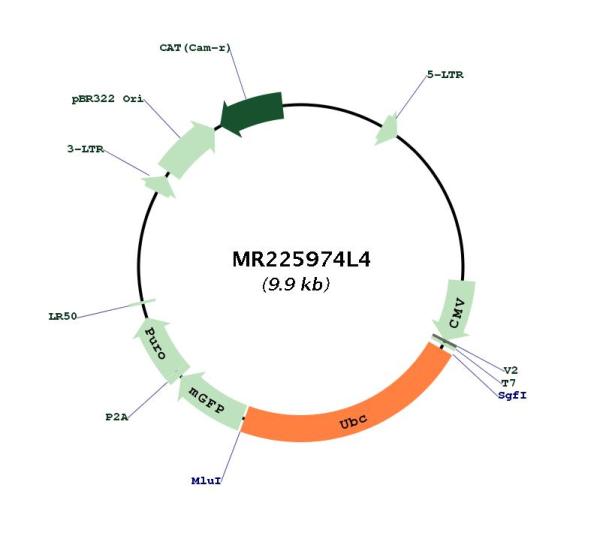Ubc (NM_019639) Mouse Tagged Lenti ORF Clone
SKU
MR225974L4
Lenti ORF clone of Ubc (mGFP-tagged) - Mouse ubiquitin C (Ubc)
-
LentiORF®
LentiORF®
Expression-ready ORF plasmid in lenti backbone
Click here to learn more.
| Product Data | |
| Type | Mouse Tagged ORF Clone |
|---|---|
| Target Symbol | Ubc |
| Synonyms | 2700054O04Rik; AI194771; Rps27a; TI-225; Uba52; Ubb |
| Vector | pLenti-C-mGFP-P2A-Puro |
| E. coli Selection | Chl (34 ug/mL) |
| Mammalian Cell Selection | Puromycin |
| Sequence Data |
ORF Nucleotide Sequence
The ORF insert of this clone is exactly the same as(MR225974).
|
| Restriction Sites |
SgfI-MluI Cloning Scheme for this gene
Plasmid Map

|
| ACCN | NM_019639 |
| ORF Size | 2202 bp |
| OTI Disclaimer | Due to the inherent nature of this plasmid, standard methods to replicate additional amounts of DNA in E. coli are highly likely to result in mutations and/or rearrangements. Therefore, OriGene does not guarantee the capability to replicate this plasmid DNA. Additional amounts of DNA can be purchased from OriGene with batch-specific, full-sequence verification at a reduced cost. Please contact our customer care team at custsupport@origene.com or by calling 301.340.3188 option 3 for pricing and delivery. The molecular sequence of this clone aligns with the gene accession number as a point of reference only. However, individual transcript sequences of the same gene can differ through naturally occurring variations (e.g. polymorphisms), each with its own valid existence. This clone is substantially in agreement with the reference, but a complete review of all prevailing variants is recommended prior to use. More info |
| OTI Annotation | This clone was engineered to express the complete ORF with an expression tag. Expression varies depending on the nature of the gene. |
| Components | The ORF clone is ion-exchange column purified and shipped in a 2D barcoded Matrix tube containing 10ug of transfection-ready, dried plasmid DNA (reconstitute with 100 ul of water). |
| Reconstitution Method | 1. Centrifuge at 5,000xg for 5min. 2. Carefully open the tube and add 100ul of sterile water to dissolve the DNA. 3. Close the tube and incubate for 10 minutes at room temperature. 4. Briefly vortex the tube and then do a quick spin (less than 5000xg) to concentrate the liquid at the bottom. 5. Store the suspended plasmid at -20°C. The DNA is stable for at least one year from date of shipping when stored at -20°C. |
| Note | Plasmids are not sterile. For experiments where strict sterility is required, filtration with 0.22um filter is required. |
| Shipping | Ambient |
| Reference Data | |
| RefSeq | NM_019639.4, NP_062613.3 |
| RefSeq Size | 2424 bp |
| RefSeq ORF | 2205 bp |
| Locus ID | 22190 |
| UniProt ID | P0CG50 |
| Cytogenetics | 5 64.18 cM |
| Summary | Ubiquitin: Exists either covalently attached to another protein, or free (unanchored). When covalently bound, it is conjugated to target proteins via an isopeptide bond either as a monomer (monoubiquitin), a polymer linked via different Lys residues of the ubiquitin (polyubiquitin chains) or a linear polymer linked via the initiator Met of the ubiquitin (linear polyubiquitin chains). Polyubiquitin chains, when attached to a target protein, have different functions depending on the Lys residue of the ubiquitin that is linked: Lys-6-linked may be involved in DNA repair; Lys-11-linked is involved in ERAD (endoplasmic reticulum-associated degradation) and in cell-cycle regulation; Lys-29-linked is involved in lysosomal degradation; Lys-33-linked is involved in kinase modification; Lys-48-linked is involved in protein degradation via the proteasome; Lys-63-linked is involved in endocytosis, DNA-damage responses as well as in signaling processes leading to activation of the transcription factor NF-kappa-B. Linear polymer chains formed via attachment by the initiator Met lead to cell signaling. Ubiquitin is usually conjugated to Lys residues of target proteins, however, in rare cases, conjugation to Cys or Ser residues has been observed. When polyubiquitin is free (unanchored-polyubiquitin), it also has distinct roles, such as in activation of protein kinases, and in signaling.[UniProtKB/Swiss-Prot Function] |
Write Your Own Review
| Product Manuals |
| FAQs |
| SDS |
| SKU | Description | Size | Price | |
|---|---|---|---|---|
| MC221162 | Ubc (untagged) - Mouse ubiquitin C (Ubc), (10ug) | 10 ug |
$1,009.00
|
|
| MG225974 | Ubc (tGFP-tagged) - Mouse ubiquitin C (Ubc), (10ug) | 10 ug |
$1,275.00
|
|
| MR225974 | Ubc (Myc-DDK-tagged) - Mouse ubiquitin C (Ubc) | 10 ug |
$1,075.00
|
|
| MR225974L3 | Lenti ORF clone of Ubc (Myc-DDK-tagged) - Mouse ubiquitin C (Ubc) | 10 ug |
$1,375.00
|
|
Citations
*Delivery time may vary from web posted schedule. Occasional delays may occur due to unforeseen
complexities in the preparation of your product. International customers may expect an additional 1-2 weeks
in shipping.










